Jason Schneider
the Camera Collector
Lovable Losers, part 2
Five more flawed cameras whose charm transcends their deficits
By Jason Schneider
Leicaflex Standard: The first 35mm SLR made by Leica (then E. Leitz Wetzlar), the original Leicaflex debuted in 1964 and received a chilly reception among diehard Leica fans who had hoped for a world class contender to go up against the Nikon F, Canonflex, Asahi Pentax, and the Contarex. Subsequently dubbed the Standard to distinguish it from its TTL-metering successors, the Leicaflex SL and SL2, it was in development for more than 5 years and officially discontinued in 1968 with the introduction of the Leicaflex SL, the first SLR with selective TTL metering. Over the Standard’s short lifespan only about 37,500 bodies were sold. Dismissed by some reviewers as “the shotgun marriage of a Leica M3, a Visoflex reflex housing, and a Leica MR meter” the non-TTL-metering Leicaflex Standard was functionally obsolete the day it was announced in 1963. And when it finally went on sale a year later, the Leicaflex with standard 50mm f/2Summicron-R lens listed for $585.00 (equivalent to over $5,000 in 2022 dollars), an astronomical price for a brand new SLR lacking many features available on other cameras costing far less.
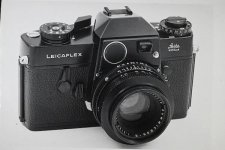
Leicaflex Standard, Mark II version provides meter turnoff via wind lever. It's quite attractive in black with excellent 50mm f/2 Summicron-R lens.
While it’s well-made, beautifully finished, and has a bright viewfinder, the original Leicaflex Standard is beset by many deficiencies: it only provides a focusing image within a central microprism circle—the entire outer area is a non-focusing aerial image. Neither the back nor the prism is interchangeable, precluding the possibility of adding back-mounted accessories or conveniently changing finders and focusing screens (features competitive high-end SLRs offered). And while its smooth operating single stroke wind lever has a moderately long throw of about 140 degrees, it’s not ratcheted so you can’t wind to the next frame in a series of shorter strokes. Incredibly, there’s no meter on-off switch on the initial version—you’ve got to cover the external meter port, store the camera in a closed case, or remove the 1.35 mercury cells. The final indignity: its non-TTL meter uses a memory-effect-prone CdS cell, and you must have it converted (at a cost of $50-$75) to work properly with currently availablde 1.5-volt silver oxide or alkaline calls, presuming you require a functional metering system.
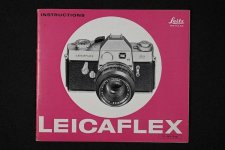
Cover of original Leicaflex Standard Mark I manual shows the chrome version with fan-shaped exposure counter at left of bio shutter speed dial in photo.
The Leicaflex Standard is nicely shaped for handholding, but it’s relatively large and quite heavy measuring 5.83 x 3.82 x 1.97 inches (W x H x D) and weighing in at 27.2 ounces (body only). Add another 24 ounces for the 50mm f/2 Summicron-R normal lens and that brings it to 51.2 ounces, a whopping 3.2 pounds.
The Leicaflex Standard was produced in 2 variants: the original Mark 1 identifiable by its fan-shaped exposure counter, and the later Mark 2, which has a round exposure counter and (glory be!) turns off the meter when the wind lever is pressed flush with the camera body. Both variants have are famously loud when you release the shutter, but the action of the instant-return mirror is well damped and the sheer mass the camera helps to attenuate any camera induced vibration. Despite its many shortcomings, all lambasted back in the day, the Leicaflex Standard is, in its own charmingly idiosyncratic way, a timeless classic. It’s exquisitely made and gorgeously finished at a level that few, if any, modern cameras can match. Its highly complex and sophisticated mirror and shutter mechanisms are masterfully executed, and thankfully quite reliable and durable. Its viewfinder is very bright even by current standards and the focusing image snaps into focus decisively. Its original line of single-cam R-mount Leitz prime lenses (35-135mm), many designed by the legendary Dr. Walter Mandler, are mechanical and optical masterpieces that deliver breathtaking imagingperformance. Its shutter release and film wind action are silky smooth and its shutter tops out at an impressive (and useful) 1/2000 sec. Even its funky, low sensitivity metering system (which has a shrouded CdS port and battery cover on the front of the pentaprism housing) works quite well in reasonably bright light and gives “fat spot” readingroughly equivalent in coverage to a 90mm lens. Cautionary note: The Leicaflex Standard works fine with 1- and 2-cam R-mount lenses but 3- cam and ROM-equipped lenses can cause problems, so beware.
So, if you just happen to have a Leicaflex Standard gathering dust, do trot it out and give it a go—you’ll be pleasantly surprised. And
if you’re tempted to acquire one, clean, functional, used examples in topnotch condition are readily available in the $200-$350 range and you can occasionally snag a nice one, complete with a 1-cam 50mm f/2 Summicron-R for around $500-600. As you might imagine Leica R lenses are expensive, and make sure any online Leicaflex purchases come with no questions asked, full return privileges—these cameras can be costly to fix and not every repair shop is willing to work on them.
Nikon EM: This cute, compact, lightweight, autoexposure-only, entry-level Nikon of 1979-1982 was aimed at point-and-shooters, especially women, stepping up to an SLR. It was roundly rejected by most Nikon fans as an “NRN” (not a real Nikon) mostly because of its plastic outer body, lack of manual exposure capability (except for its single timed mechanical speed of 1/90 sec (at the “M90” setting) plus B). Its bottom-of-the-line introductory list price of $231 (body with 50mm f/1.8 lens), also reinforced its image of being a cheap imposter aimed at the huddled masses. Despite being built to somewhat lower dimensional tolerances than middle- and upper-tier Nikons of its day and providing only aperture-priority autoexposure and limited unmetered manual exposure setting options, the Nikon EM is a charming camera with an elegant form factor (it was designed the noted Italian automobile stylist Giorgetto Giugiaro), and its once reviled 50mm f/1.8 Series-E Nikon (not Nikkor!) normal lens is now considered a classic.
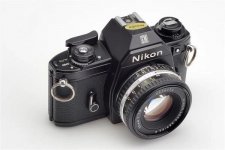
Nikon EM with excellent 50mm f/1.8 Series-E Nikon Lens. Its elegant form factor was penned by an Italian car designer and it only available in black.
The Nikon EM body measures a compact 3.4 x 5.3 x 2.1 inches (H x W x D), weighs a mere 16 oz., and features a copper-aluminum alloy chasses with fiber-reinforced top and bottom covers. Its Seiko MFC-E electronically controlled shutter provides autoexposure shutter speeds from 1-1/1000 sec, and its silicon cell (SBC) autoexposure system provides classic Nikon 60/40-percent center-weighted readings with camera-selected shutter speeds read out via a needle on the left-hand side of the finder. The fixed finder screen has Nikon’s standard 3mm split-image rangefinder surrounded by a 1mm microprism collar, and there’s a low light warning beeper. Since the EM uses a porroprism constructed of mirrors rather than the solid glass pentaprism used in muddle- and upper-tier Nikons, its viewing image is dimmer. One obscure feature of the EM is that it provides a shutter speed of about 1/1000 sec on the “Auto” setting when the S-76 button batteries are removed. Two nice touches: It accepts the compact 2 fps Nikon MD-E winder and the dedicated Nikon SB-E auto-flash. Warning: it doesn’t work with early non-AI Nikkor lenses that can foul the mirror, but it accepts all Series-E Nikon and most AI and AS-S Nikkor lenses.
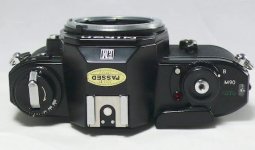
Top view of Nikon EM shows that mode dial on the right has only 3 settings: Auto (aperture priority) M90 (a 1/90 sec mechanical speed), and B
:
The humble little Nikon EM has proven to be quite reliable and durable, surpassing even its higher-end stablemates in that regard, and it’s a very nice fun camera for general shooting (though perhaps not in very low light), and a great “casual” backup camera for analog Nikon shooters. If you’re tempted to acquire one of these black-only beauties, the best news is that you can snag a clean functional example with 50mm f/1.8 Series-E Nikon lens for about 100 bucks, and a pristine body for around $50. Just don’t but one “as is” with no returns because broken EMs cost more to fix than they’re worth and spare parts must be cannibalized.
Canonflex RM: The Canonflex RM of 1962 was the second Japanese SLR (after the rare primo collectible Konica F of 1960) to feature a built-in exposure meter. A veritable tank of a camera, it used the same body shell as the ultra-robust Canonflex (Canon’s first top-of-the-line SLR that was eclipsed by the mighty Nikon F), but its fixed pentaprism is set very low in the body, giving it an aggressive or assertive look. Its external selenium cell meter is coupled to the large shutter speed dial that controls the two-axis, horizontal, cloth focal plane, 1-1/1000 sec plus B shutter, but you must manually transfer the proper exposure aperture, read out by a needle in the top-mounted meter scale window, to the aperture ring on the lens. The finder is quite bright, has a magnification of 0.8x, and the standard screen (there were 2 other factory installed options) has a central split-image rangefinder. Other features: an inconveniently recessed, top-mounted, single stroke 120-degree wind lever, film speed settings ISO 10-800, meter sensitivity EV6-17 at ISO 100, a folding rewind crank, and a built-in mechanical self-timer.
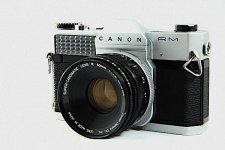
Canonflex RM: Its low-mounted pentaprism gives it a rugged "muscular" look and its external selenium meter cell proclaims its its vintage provenance.
The Canonflex RM body measures 5.7 x 3.6 x 1.85 inches (W x H x D) and weighs in at a hefty 2 pounds, 1.2 ounces. If you want the vintage Canon SLR experience, in a robust, fine-performing, durable camera with access to a huge selection of outstanding Canon FL and FD breech-lock lenses, the odd looking and underappreciated Canonflex RM is a good way to go. Just make sure the meter’s working because they’re a bear to repair. You can glom onto a clean fully functional example with the excellent Super-Canonmatic R 50mm f/1.8 lens for about $150-$200, and sometimes less, in all the usual places. Just make sure the seller offers no questions asked return privileges because repairs are costly.
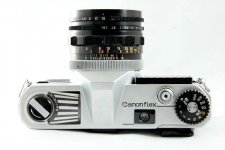
Top view of Canonflex RM shows metering window with needle and rewind crank (left) and recessed wind lever (right) behind large shutter speed/ASA dial.
Rollei Magic II: It seems improbable today that Rollei (then Franke & Heidecke of Braunschweig, Germany) would design and produce two successive autoexposure Rolleiflex twin-lens reflexes aimed at novices who wanted to achieve topnotch image quality without having to master those pesky exposure settings, but they did. TLRs were wildly popular in the ‘50s and early ‘60s and the idea seemed plausible—in fact Sem (the French maker of the Semflex TLR line) and Ricoh in Japan, both tried the same thing. None of these simplified or autoexposure TLRs was a great success in the marketplace, but they sure are fascinating.
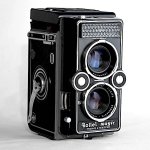
Original Rollei Magic (later dubbed model I) features selenium cell controlled autoexposure, but in manual the only timed shutter speed is 1/30 sec. Bummer.
The original Rollei Magic of 1960-1962 (subsequently dubbed the model 1) has a 75mm f/3.5 Schneider Xenar taking lens and a75mm f/3.5 Heidosmat viewing lens (also a Xenar!) that focus by sliding the front cell back and forth with respect to the fixed rear optical group (a system unique to the Rollei Magic 1 & II). The selenium cell metering system provides automatic exposure speeds from 1/30-1/300 sec at f/stops ranging from f/3.5-f/22, but the Prontormat-S leaf shutter only provides two manual settings, 1/30 sec and B, both of which allow f/stop settings of f/3.5-f/22. The body (with viewing hood closed) measures 3.46 x 4.17 x 5.79 inches (W x D x H) and weighs in at 2 pounds, 3.3 ounces. Although the Rolle Magic 1 is capable of excellent on-film performance, it’s widely considered a dog because, if the meter goes in the fritz and can’t be fixed (an all-too-common occurrence) you’re essentially dead in the water since you can only shoot manually at 1/30 sec or B. Incidentally both models provide film speed settings ranging from ASA 12-1600, a wider range than many cameras of that era.
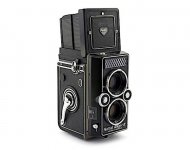
Rollei Magic II of 1962-1968 is very similar to the original model I, but its shutter was revised to provide a full 1/30-1/500 sec range of speeds in manual mode.
The Rollei Magic II of 1962-1968 is basically the same camera as the model 1, but with one crucial difference—it has a different version of the Prontormat-S shutter that enables shutter speed settings of 1/30-1/500 sec in both autoexposure and manual modes, plus B in the latter, so you can set a (relatively) full range of shutter speeds along with apertures of f/3.5-f/22 whether the meter is working or not. Getting either model repaired is challenging at this point so the ability to be sable to use the camera manually means that the Rollei Magic II is a far better choice for user-collectors.
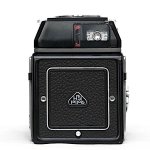
Topo view of Rollei Magic I shows uncalibrated meter needle to confirm whether you're in metering range, and film speed setting window. Neither model provides metered manual exposure, bot only the Rollei Magic II offers a full range of shutter speed and f/stop settings inn manual mode, making in the preferred choice for shooters.
Both Rollei Magics are very well made and finished, and have excellent lenses, an bright, contrasty viewfinders. And while their feasture setds s are more akin to a Rolleicord than a Roilleiflex (no auto first frame positioning, for example) they’re lots of fun to shoot with and accept Rollei Bayonet 2 accessories such as Rolleinar closeup lenses. For the record, these are limited production classics—the total number of Rollei Magic Is and IIs turned out by the factory is only about 25,000 and 12,600 respectively. If you hanker for one of these quaint and curious TLRs, a clean working Rollei Magic I will set you back about $150-$200, and a II about $100-$150 more than that. Prices and functionality vary widely so caveat emptor.
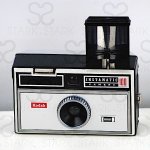
The First Kodak Instamatic: The iconic Instamatic 100 pioneered the 126 instant loading cartridge. Not raised built-in flash designed for tiny AG-1 flashbulbs.
Kodak Instamatic 100: The first of a long line of Kodak Instamatic cameras, the simple, basic Instamatic 100 that debuted in 1963 was a simple, snapshot camera based on the Kodapak 126 cartridge, an easy-loading system that was virtually foolproof and eliminated the need to thread the film or paper leader onto a take-up spool. The plastic 126 cartridge, which only fit into the camera when correctly oriented, provided a nominal 28x28mm format on paper-backed 35mm film that was masked down to an actual format size of 26.5mm square. The film featured one registration hole (perforation) per image, and frame numbers were read out in a small window at the rear of the cartridge. The system was enormously successful---by 1970 Kodak alone had manufactured over 50-million Instamatics. Scores of camera-making companies in the U.S., Japan, and Germany also offered 126 cartridge cameras, mostly simple snapshot cameras, but many with more advanced features. Kodak, Rollei, Zeiss-Ikon, and Ricoh even fielded interchangeable lens 126 SLRs, though their performance, especially with fast lenses was limited by the 126 cartridge’s inherent inability to provide consistent film flatness. It was probably the technical success of easy-loading, fully automatic 35mm point-and-shoot cameras in the late ‘70s that hastened the demise of the format, and the system petered out in the ‘80s. Kodak ceased manufacturing 126 Instamatic cartridges in 2000.
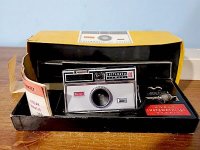
Kodak Instamatic 100 in its original box with instruction manual. It's now a filmless classic for display only, but still a pretty good deal for around 20 bucks!
The charmingly iconic little plastic-bodied Instamatic 100 features a fixed-focus 43mm f/11 acrylic lens, a simple 2-speed (1/40 and 1/90 sec) shutter, top-mounted film-wind lever, and a pop-up flash designed for baseless AG-1 flashbulbs. It sold for $15.95 list, and was the basis for a an extensive series of Instamatics with spring motor drive, flash cube sockets, rangefinders, faster lenses, etc. An original Kodak Instamatic 100 is a cute, perky, collectible classic that’s readily available online at paltry prices in the $7-$20 range (mint ones in their original boxes go for a bit more). Just don’t expect to take pictures with it.
Five more flawed cameras whose charm transcends their deficits
By Jason Schneider
Leicaflex Standard: The first 35mm SLR made by Leica (then E. Leitz Wetzlar), the original Leicaflex debuted in 1964 and received a chilly reception among diehard Leica fans who had hoped for a world class contender to go up against the Nikon F, Canonflex, Asahi Pentax, and the Contarex. Subsequently dubbed the Standard to distinguish it from its TTL-metering successors, the Leicaflex SL and SL2, it was in development for more than 5 years and officially discontinued in 1968 with the introduction of the Leicaflex SL, the first SLR with selective TTL metering. Over the Standard’s short lifespan only about 37,500 bodies were sold. Dismissed by some reviewers as “the shotgun marriage of a Leica M3, a Visoflex reflex housing, and a Leica MR meter” the non-TTL-metering Leicaflex Standard was functionally obsolete the day it was announced in 1963. And when it finally went on sale a year later, the Leicaflex with standard 50mm f/2Summicron-R lens listed for $585.00 (equivalent to over $5,000 in 2022 dollars), an astronomical price for a brand new SLR lacking many features available on other cameras costing far less.

Leicaflex Standard, Mark II version provides meter turnoff via wind lever. It's quite attractive in black with excellent 50mm f/2 Summicron-R lens.
While it’s well-made, beautifully finished, and has a bright viewfinder, the original Leicaflex Standard is beset by many deficiencies: it only provides a focusing image within a central microprism circle—the entire outer area is a non-focusing aerial image. Neither the back nor the prism is interchangeable, precluding the possibility of adding back-mounted accessories or conveniently changing finders and focusing screens (features competitive high-end SLRs offered). And while its smooth operating single stroke wind lever has a moderately long throw of about 140 degrees, it’s not ratcheted so you can’t wind to the next frame in a series of shorter strokes. Incredibly, there’s no meter on-off switch on the initial version—you’ve got to cover the external meter port, store the camera in a closed case, or remove the 1.35 mercury cells. The final indignity: its non-TTL meter uses a memory-effect-prone CdS cell, and you must have it converted (at a cost of $50-$75) to work properly with currently availablde 1.5-volt silver oxide or alkaline calls, presuming you require a functional metering system.

Cover of original Leicaflex Standard Mark I manual shows the chrome version with fan-shaped exposure counter at left of bio shutter speed dial in photo.
The Leicaflex Standard is nicely shaped for handholding, but it’s relatively large and quite heavy measuring 5.83 x 3.82 x 1.97 inches (W x H x D) and weighing in at 27.2 ounces (body only). Add another 24 ounces for the 50mm f/2 Summicron-R normal lens and that brings it to 51.2 ounces, a whopping 3.2 pounds.
The Leicaflex Standard was produced in 2 variants: the original Mark 1 identifiable by its fan-shaped exposure counter, and the later Mark 2, which has a round exposure counter and (glory be!) turns off the meter when the wind lever is pressed flush with the camera body. Both variants have are famously loud when you release the shutter, but the action of the instant-return mirror is well damped and the sheer mass the camera helps to attenuate any camera induced vibration. Despite its many shortcomings, all lambasted back in the day, the Leicaflex Standard is, in its own charmingly idiosyncratic way, a timeless classic. It’s exquisitely made and gorgeously finished at a level that few, if any, modern cameras can match. Its highly complex and sophisticated mirror and shutter mechanisms are masterfully executed, and thankfully quite reliable and durable. Its viewfinder is very bright even by current standards and the focusing image snaps into focus decisively. Its original line of single-cam R-mount Leitz prime lenses (35-135mm), many designed by the legendary Dr. Walter Mandler, are mechanical and optical masterpieces that deliver breathtaking imagingperformance. Its shutter release and film wind action are silky smooth and its shutter tops out at an impressive (and useful) 1/2000 sec. Even its funky, low sensitivity metering system (which has a shrouded CdS port and battery cover on the front of the pentaprism housing) works quite well in reasonably bright light and gives “fat spot” readingroughly equivalent in coverage to a 90mm lens. Cautionary note: The Leicaflex Standard works fine with 1- and 2-cam R-mount lenses but 3- cam and ROM-equipped lenses can cause problems, so beware.
So, if you just happen to have a Leicaflex Standard gathering dust, do trot it out and give it a go—you’ll be pleasantly surprised. And
if you’re tempted to acquire one, clean, functional, used examples in topnotch condition are readily available in the $200-$350 range and you can occasionally snag a nice one, complete with a 1-cam 50mm f/2 Summicron-R for around $500-600. As you might imagine Leica R lenses are expensive, and make sure any online Leicaflex purchases come with no questions asked, full return privileges—these cameras can be costly to fix and not every repair shop is willing to work on them.
Nikon EM: This cute, compact, lightweight, autoexposure-only, entry-level Nikon of 1979-1982 was aimed at point-and-shooters, especially women, stepping up to an SLR. It was roundly rejected by most Nikon fans as an “NRN” (not a real Nikon) mostly because of its plastic outer body, lack of manual exposure capability (except for its single timed mechanical speed of 1/90 sec (at the “M90” setting) plus B). Its bottom-of-the-line introductory list price of $231 (body with 50mm f/1.8 lens), also reinforced its image of being a cheap imposter aimed at the huddled masses. Despite being built to somewhat lower dimensional tolerances than middle- and upper-tier Nikons of its day and providing only aperture-priority autoexposure and limited unmetered manual exposure setting options, the Nikon EM is a charming camera with an elegant form factor (it was designed the noted Italian automobile stylist Giorgetto Giugiaro), and its once reviled 50mm f/1.8 Series-E Nikon (not Nikkor!) normal lens is now considered a classic.

Nikon EM with excellent 50mm f/1.8 Series-E Nikon Lens. Its elegant form factor was penned by an Italian car designer and it only available in black.
The Nikon EM body measures a compact 3.4 x 5.3 x 2.1 inches (H x W x D), weighs a mere 16 oz., and features a copper-aluminum alloy chasses with fiber-reinforced top and bottom covers. Its Seiko MFC-E electronically controlled shutter provides autoexposure shutter speeds from 1-1/1000 sec, and its silicon cell (SBC) autoexposure system provides classic Nikon 60/40-percent center-weighted readings with camera-selected shutter speeds read out via a needle on the left-hand side of the finder. The fixed finder screen has Nikon’s standard 3mm split-image rangefinder surrounded by a 1mm microprism collar, and there’s a low light warning beeper. Since the EM uses a porroprism constructed of mirrors rather than the solid glass pentaprism used in muddle- and upper-tier Nikons, its viewing image is dimmer. One obscure feature of the EM is that it provides a shutter speed of about 1/1000 sec on the “Auto” setting when the S-76 button batteries are removed. Two nice touches: It accepts the compact 2 fps Nikon MD-E winder and the dedicated Nikon SB-E auto-flash. Warning: it doesn’t work with early non-AI Nikkor lenses that can foul the mirror, but it accepts all Series-E Nikon and most AI and AS-S Nikkor lenses.

Top view of Nikon EM shows that mode dial on the right has only 3 settings: Auto (aperture priority) M90 (a 1/90 sec mechanical speed), and B
:
The humble little Nikon EM has proven to be quite reliable and durable, surpassing even its higher-end stablemates in that regard, and it’s a very nice fun camera for general shooting (though perhaps not in very low light), and a great “casual” backup camera for analog Nikon shooters. If you’re tempted to acquire one of these black-only beauties, the best news is that you can snag a clean functional example with 50mm f/1.8 Series-E Nikon lens for about 100 bucks, and a pristine body for around $50. Just don’t but one “as is” with no returns because broken EMs cost more to fix than they’re worth and spare parts must be cannibalized.
Canonflex RM: The Canonflex RM of 1962 was the second Japanese SLR (after the rare primo collectible Konica F of 1960) to feature a built-in exposure meter. A veritable tank of a camera, it used the same body shell as the ultra-robust Canonflex (Canon’s first top-of-the-line SLR that was eclipsed by the mighty Nikon F), but its fixed pentaprism is set very low in the body, giving it an aggressive or assertive look. Its external selenium cell meter is coupled to the large shutter speed dial that controls the two-axis, horizontal, cloth focal plane, 1-1/1000 sec plus B shutter, but you must manually transfer the proper exposure aperture, read out by a needle in the top-mounted meter scale window, to the aperture ring on the lens. The finder is quite bright, has a magnification of 0.8x, and the standard screen (there were 2 other factory installed options) has a central split-image rangefinder. Other features: an inconveniently recessed, top-mounted, single stroke 120-degree wind lever, film speed settings ISO 10-800, meter sensitivity EV6-17 at ISO 100, a folding rewind crank, and a built-in mechanical self-timer.

Canonflex RM: Its low-mounted pentaprism gives it a rugged "muscular" look and its external selenium meter cell proclaims its its vintage provenance.
The Canonflex RM body measures 5.7 x 3.6 x 1.85 inches (W x H x D) and weighs in at a hefty 2 pounds, 1.2 ounces. If you want the vintage Canon SLR experience, in a robust, fine-performing, durable camera with access to a huge selection of outstanding Canon FL and FD breech-lock lenses, the odd looking and underappreciated Canonflex RM is a good way to go. Just make sure the meter’s working because they’re a bear to repair. You can glom onto a clean fully functional example with the excellent Super-Canonmatic R 50mm f/1.8 lens for about $150-$200, and sometimes less, in all the usual places. Just make sure the seller offers no questions asked return privileges because repairs are costly.

Top view of Canonflex RM shows metering window with needle and rewind crank (left) and recessed wind lever (right) behind large shutter speed/ASA dial.
Rollei Magic II: It seems improbable today that Rollei (then Franke & Heidecke of Braunschweig, Germany) would design and produce two successive autoexposure Rolleiflex twin-lens reflexes aimed at novices who wanted to achieve topnotch image quality without having to master those pesky exposure settings, but they did. TLRs were wildly popular in the ‘50s and early ‘60s and the idea seemed plausible—in fact Sem (the French maker of the Semflex TLR line) and Ricoh in Japan, both tried the same thing. None of these simplified or autoexposure TLRs was a great success in the marketplace, but they sure are fascinating.

Original Rollei Magic (later dubbed model I) features selenium cell controlled autoexposure, but in manual the only timed shutter speed is 1/30 sec. Bummer.
The original Rollei Magic of 1960-1962 (subsequently dubbed the model 1) has a 75mm f/3.5 Schneider Xenar taking lens and a75mm f/3.5 Heidosmat viewing lens (also a Xenar!) that focus by sliding the front cell back and forth with respect to the fixed rear optical group (a system unique to the Rollei Magic 1 & II). The selenium cell metering system provides automatic exposure speeds from 1/30-1/300 sec at f/stops ranging from f/3.5-f/22, but the Prontormat-S leaf shutter only provides two manual settings, 1/30 sec and B, both of which allow f/stop settings of f/3.5-f/22. The body (with viewing hood closed) measures 3.46 x 4.17 x 5.79 inches (W x D x H) and weighs in at 2 pounds, 3.3 ounces. Although the Rolle Magic 1 is capable of excellent on-film performance, it’s widely considered a dog because, if the meter goes in the fritz and can’t be fixed (an all-too-common occurrence) you’re essentially dead in the water since you can only shoot manually at 1/30 sec or B. Incidentally both models provide film speed settings ranging from ASA 12-1600, a wider range than many cameras of that era.

Rollei Magic II of 1962-1968 is very similar to the original model I, but its shutter was revised to provide a full 1/30-1/500 sec range of speeds in manual mode.
The Rollei Magic II of 1962-1968 is basically the same camera as the model 1, but with one crucial difference—it has a different version of the Prontormat-S shutter that enables shutter speed settings of 1/30-1/500 sec in both autoexposure and manual modes, plus B in the latter, so you can set a (relatively) full range of shutter speeds along with apertures of f/3.5-f/22 whether the meter is working or not. Getting either model repaired is challenging at this point so the ability to be sable to use the camera manually means that the Rollei Magic II is a far better choice for user-collectors.

Topo view of Rollei Magic I shows uncalibrated meter needle to confirm whether you're in metering range, and film speed setting window. Neither model provides metered manual exposure, bot only the Rollei Magic II offers a full range of shutter speed and f/stop settings inn manual mode, making in the preferred choice for shooters.
Both Rollei Magics are very well made and finished, and have excellent lenses, an bright, contrasty viewfinders. And while their feasture setds s are more akin to a Rolleicord than a Roilleiflex (no auto first frame positioning, for example) they’re lots of fun to shoot with and accept Rollei Bayonet 2 accessories such as Rolleinar closeup lenses. For the record, these are limited production classics—the total number of Rollei Magic Is and IIs turned out by the factory is only about 25,000 and 12,600 respectively. If you hanker for one of these quaint and curious TLRs, a clean working Rollei Magic I will set you back about $150-$200, and a II about $100-$150 more than that. Prices and functionality vary widely so caveat emptor.

The First Kodak Instamatic: The iconic Instamatic 100 pioneered the 126 instant loading cartridge. Not raised built-in flash designed for tiny AG-1 flashbulbs.
Kodak Instamatic 100: The first of a long line of Kodak Instamatic cameras, the simple, basic Instamatic 100 that debuted in 1963 was a simple, snapshot camera based on the Kodapak 126 cartridge, an easy-loading system that was virtually foolproof and eliminated the need to thread the film or paper leader onto a take-up spool. The plastic 126 cartridge, which only fit into the camera when correctly oriented, provided a nominal 28x28mm format on paper-backed 35mm film that was masked down to an actual format size of 26.5mm square. The film featured one registration hole (perforation) per image, and frame numbers were read out in a small window at the rear of the cartridge. The system was enormously successful---by 1970 Kodak alone had manufactured over 50-million Instamatics. Scores of camera-making companies in the U.S., Japan, and Germany also offered 126 cartridge cameras, mostly simple snapshot cameras, but many with more advanced features. Kodak, Rollei, Zeiss-Ikon, and Ricoh even fielded interchangeable lens 126 SLRs, though their performance, especially with fast lenses was limited by the 126 cartridge’s inherent inability to provide consistent film flatness. It was probably the technical success of easy-loading, fully automatic 35mm point-and-shoot cameras in the late ‘70s that hastened the demise of the format, and the system petered out in the ‘80s. Kodak ceased manufacturing 126 Instamatic cartridges in 2000.

Kodak Instamatic 100 in its original box with instruction manual. It's now a filmless classic for display only, but still a pretty good deal for around 20 bucks!
The charmingly iconic little plastic-bodied Instamatic 100 features a fixed-focus 43mm f/11 acrylic lens, a simple 2-speed (1/40 and 1/90 sec) shutter, top-mounted film-wind lever, and a pop-up flash designed for baseless AG-1 flashbulbs. It sold for $15.95 list, and was the basis for a an extensive series of Instamatics with spring motor drive, flash cube sockets, rangefinders, faster lenses, etc. An original Kodak Instamatic 100 is a cute, perky, collectible classic that’s readily available online at paltry prices in the $7-$20 range (mint ones in their original boxes go for a bit more). Just don’t expect to take pictures with it.
Pál_K
Cameras. I has it.
Thank you, Jason, for these fun articles; I really love them.
The EM is definitely a good looking camera. I see them often. The FG looks similar and offers much more control, but of course costs more.
As a kid I had an Instamatic of some form - I wanted it to look like a “real camera”, so I put black tape over the shiny parts and bought an inexpensive telephoto attachment which I kept permanently over the lens because it made the camera look more serious. I should have it even today, but haven’t found it yet.
The EM is definitely a good looking camera. I see them often. The FG looks similar and offers much more control, but of course costs more.
As a kid I had an Instamatic of some form - I wanted it to look like a “real camera”, so I put black tape over the shiny parts and bought an inexpensive telephoto attachment which I kept permanently over the lens because it made the camera look more serious. I should have it even today, but haven’t found it yet.
Mackinaw
Think Different
I have the Leicaflex Standard. Meter doesn't work and there are a few internal dark spots in the viewfinder, but this camera is a joy to use. Incredibly solid and silky smooth. Plus probably the most satisfying shutter "clunk" of any camera I own.
JIm B.
JIm B.
Retro-Grouch
Well-known
Though an Exa IIB was my first "real" camera, the Instamatic 100, a Christmas present when I was eleven, started it all. Cleopatra, our long-suffering Golden Retriever, endured many portrait sessions in front of that camera. Both are sadly missed!
Dralowid
Michael
Somewhere I have an Instamatic 50. Did this come before the 100 or was it a later discount model?
Got me thinking, one internet source says the 50 came out in the UK in advance of the 100 in US. Why on earth would Kodak launch something in the UK before the US? Maybe they thought the 50 had insufficient bells and whistles for the demanding US customer....
Got me thinking, one internet source says the 50 came out in the UK in advance of the 100 in US. Why on earth would Kodak launch something in the UK before the US? Maybe they thought the 50 had insufficient bells and whistles for the demanding US customer....
p.giannakis
Pan Giannakis
Thank you Jason for these articles, I always enjoy them.
The Nikon EM was one of those cameras that I never got on with. There were quite a few things there that I didn't like - the meter wouldn't engage until the frame counter was advanced to 1 meaning that you could never get more than 36 frames from this little camera (sometimes only 35 if you wasted too much film loading it). Also it provided backlight compensation but not under exposure settings.
I stayed with the Pentax ME (and still have it and use it) because it addressed all these and actually had a much better viewfinder.
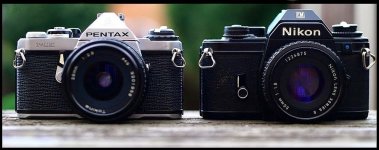
The Nikon EM was one of those cameras that I never got on with. There were quite a few things there that I didn't like - the meter wouldn't engage until the frame counter was advanced to 1 meaning that you could never get more than 36 frames from this little camera (sometimes only 35 if you wasted too much film loading it). Also it provided backlight compensation but not under exposure settings.
I stayed with the Pentax ME (and still have it and use it) because it addressed all these and actually had a much better viewfinder.

KoNickon
Nick Merritt
There's something very cool about the Leicaflex Standard -- the viewfinder is like that of a rangefinder camera (as is the non-TTL meter). I have one of the version 2 that's fully working (and a nonworking version 1). Not great for macro work, because of the non-TTL meter, but fine otherwise. I hear tell these are very hard to service though.
I've never beheld a Rollei-Magic, much less used one. I might be tempted for the right price, taking the warnings about version I into account. Fascinating that it's a front-cell focus design.
I've never beheld a Rollei-Magic, much less used one. I might be tempted for the right price, taking the warnings about version I into account. Fascinating that it's a front-cell focus design.
Share:

